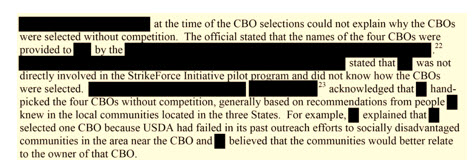WASHINGTON, Oct. 22, 2014 – A report released Tuesday by USDA’s Office of Inspector General (OIG) indicates that almost $3 million intended to help small, beginning and socially disadvantaged farmers and ranchers was not used properly. However, a USDA spokesperson says, "The recommendations in this report have been implemented already or are in the process of being addressed. The events described in the report occurred in 2010. Since then, the Secretary moved the management of the StrikeForce initiative out of the Office of Advocacy and Outreach.”
This is the latest in a series of reports issued by OIG, after a hotline complaint alleged in Oct. 2011 that USDA’s Office of Advocacy and Outreach (OAO), an office within Departmental Management (DM) under USDA’s Pearlie Reed at that time, was being mismanaged. As a result, Agriculture Secretary Tom Vilsack asked OIG to conduct an audit of OAO’s grant management process, prior to the 2012 selection process.
At that time, OIG found that the applicants selected for grants under the Outreach and Assistance for Socially Disadvantaged Farmers and Ranchers Program were likely, “not the most meritorious and deserving candidates” and noted that OAO officials “disregarded regulatory requirements and guidelines in making those selections,” according to its report. The OIG dug deeper, and found even more wide-spread problems.
Initially created as part of the 2008 Farm Bill, the OAO was intended to improve the focus on small, beginning and socially disadvantaged farmers. In September 2010, the Secretary of Agriculture established an initiative through OAO, called the “StrikeForce,” to assist agricultural producers and communities in poverty - stricken and predominantly minority areas to gain access to USDA programs.
USDA used community - based organizations (CBOs) to pilot the initiative and perform outreach activities in Arkansas, Georgia, and Mississippi. USDA DM officials stated that the
“CBOs had more credibility in those States than local USDA agency officials,” according to OIG’s report.
A total of 13 USDA agencies, as well as the People’s Garden Initiative, transferred almost $2.7 million through reimbursable agreements to fund the “StrikeForce Initiative” pilot program.
However, in violation of federal rules which require requests for proposals and various approvals, the “OAO, at the direction of DM officials, noncompetitively selected four CBOs to participate” in the pilot program,” the OIG wrote.
The OAO awarded cooperative agreements totaling $1.7 million to the CBOs as follows: $500,000 to a CBO in Georgia, $200,000 to one CBO in Mississippi, $600,000 to a second CBO in Mississippi, and $400,000 to a CBO in Arkansas – where funds were spent on such projects as “collecting assessments of flood and wind damage to crops, as well as conducting cooking classes.”
Some parts of the OIG report are blacked out, and therefore, difficult to interpret. For example:

The OIG questioned whether these CBOs would have been selected if there have been an open and competitive application process because the “CBO’s, in general, had questionable qualifications.” For example, the report noted that “three of the four CBOs had little or no experience with either USDA programs or outreach activities.” One CBO had been in operation only four months prior to receiving funds, while another did not have sufficient staff or management and could not use the funds during the two-year agreement. In addition, OIG found that the “OAO did not adequately monitor and measure the accomplishments and results of the CBOs,” and was “unaware that approximately $303,000 in funds had expired and were not returned to USDA, as required.
Pearlie Reed, a former NRCS Chief who led DM and oversaw the OAO, retired in June of 2012 – just two weeks after the first inspector general’s report. In a statement at that time, Vilsack said Reed was leaving for personal reasons and that he had urged him to stay, citing his “distinguished public service to USDA and the Obama Administration.”
“USDA's StrikeForce Initiative continues to have tremendous impact in rural America by bringing needed services, resources and opportunities to 770 persistently poor counties in 20 states,” noted USDA’s spokesperson in a statement emailed to Agri-Pulse. “USDA takes this OIG report and all efforts to maintain program accountability very seriously so that all of this critical program's resources are used to strengthen rural communities as intended."
#30
For more news, go to www.agri-pulse.com.
